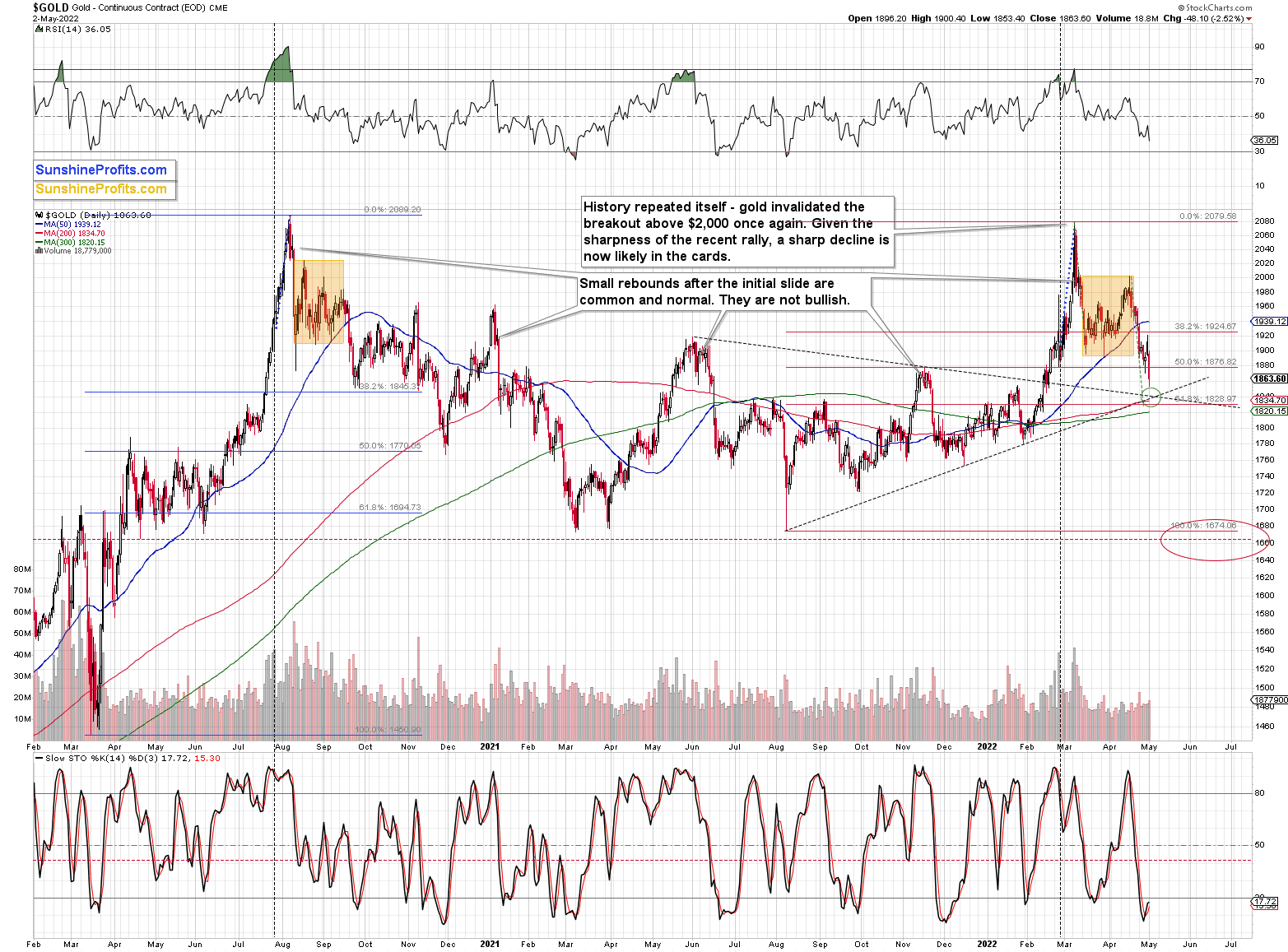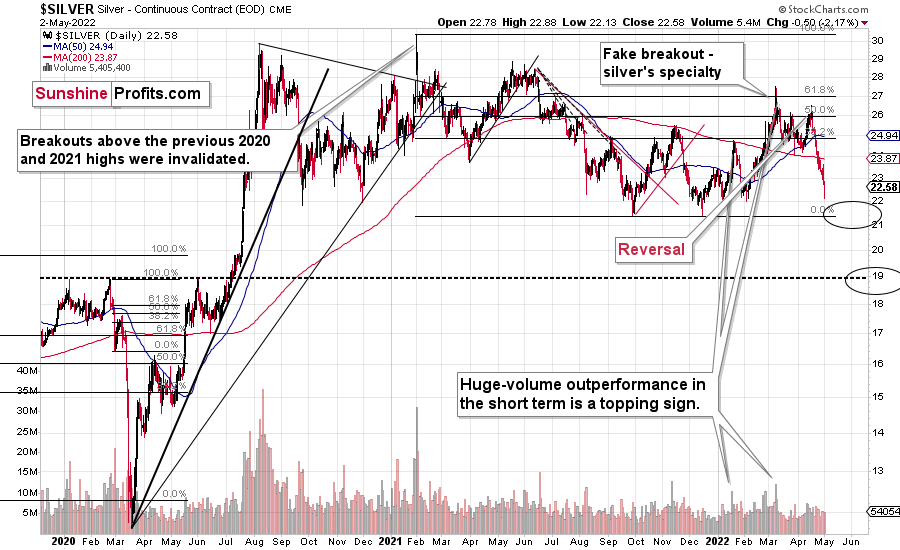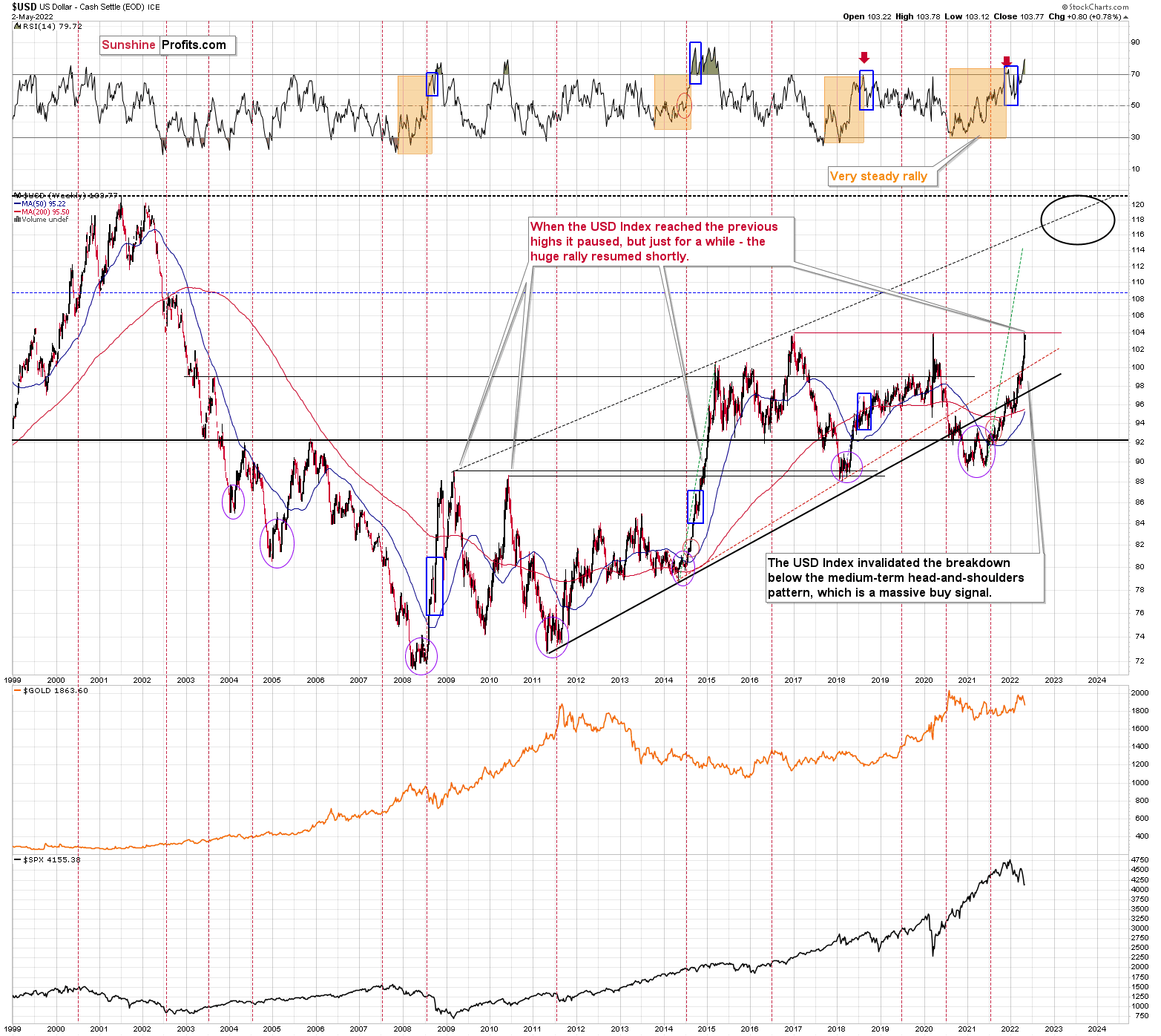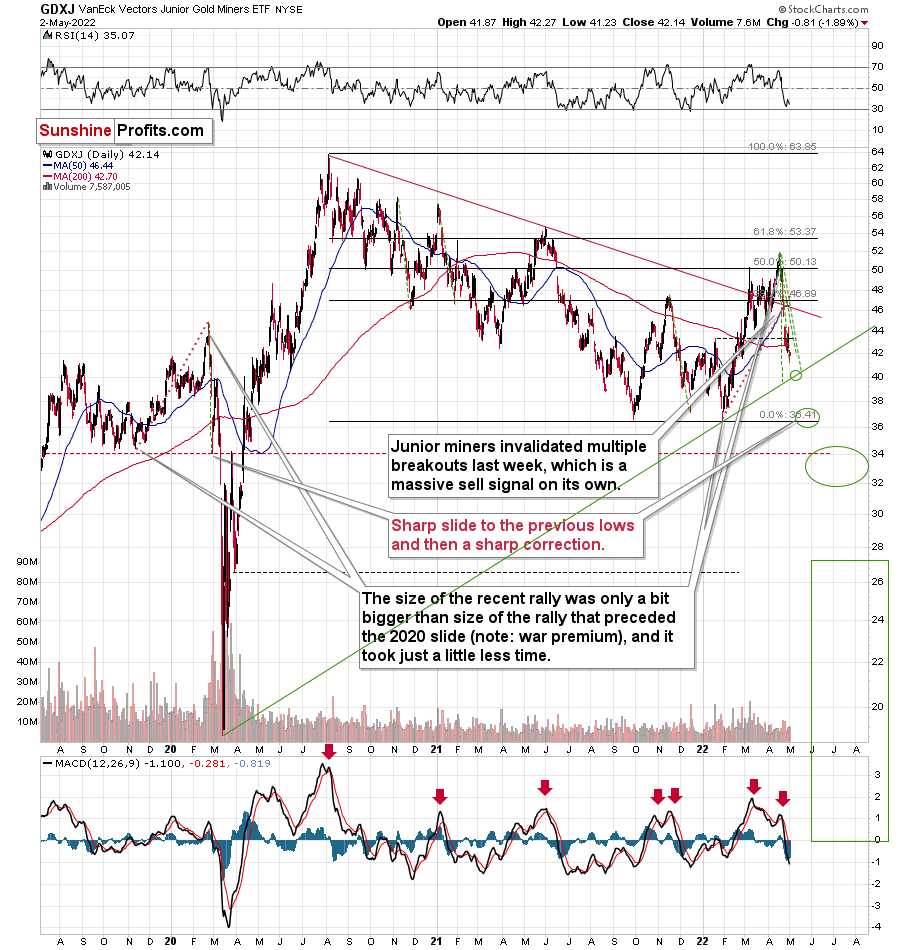Briefly: in our opinion, full (300% of the regular position size) speculative short positions in junior mining stocks are justified from the risk/reward point of view at the moment of publishing this Alert. We are adjusting the exit price levels for the current short position.
Today’s analysis once again going to be relatively brief, as practically everything that I wrote in Friday’s flagship analysis remains up-to-date.
The thing that I would like to emphasize today is that yesterday, gold moved close to its target area, but not right to it. The same happened in silver. Mining stocks moved lower, but they didn’t move particularly close to our target area.
Let’s take a closer look.
Gold ended the day at $1,863.60 – only about $20 above the triangle-vertex-based target.
Silver declined by $0.50 and is almost at its previous 2021 lows. Almost, but not there yet.
Interestingly, yesterday’s decline materialized along with a rally in the USD Index.
What’s so interesting about it is that while gold and silver moved to new short-term lows, the USD Index didn’t move to new highs. It moved almost to its recent highs. Do you see the “almost” pattern? Since all above-mentioned markets are almost at their support/resistance levels, then the theory that they are all about to correct gains more credibility.
Let’s not forget that we have two triangle-vertex-based reversal points today/tomorrow in gold and junior miners and the Fed’s interest rate decision is tomorrow. And since the markets tend to move on rumor and correct on facts, we might see a relief rally in the PMs once Fed raises the rates.
What does it tell us with regard to mining stocks’ very near-term performance?
Well, it tells us that miners are no longer likely to correct to their 2021 and 2022 lows before starting a very short-term correction.
If they did, it would imply miners’ weakness at the end of a given decline, and what usually tends to happen is that miners show some kind of strength before rallying. Consequently, if gold is about to decline by just about $20, and miners are about to either show strength or at least not to show weakness, then one shouldn’t expect the GDXJ to decline another $5 in response to a $20 decline in gold.
Instead, it seems justified to look for a target that’s relatively close to the current price levels.
Fortunately, there it was not difficult to find it.
The rising green support line based on the previous lows provides near-term support, and if GDXJ reversed (briefly!) at it, it would be in perfect tune with the sizes of the previous short-term declines. I marked the latter with green, dashed lines. They fully support the scenario, in which GDXJ forms a temporary bottom close to the $40 level.
And that’s the near-term target to which I’ll adjust the exit prices of our current short position.
I previously wrote that I might or might not want to trade this short-term rebound, depending on how likely it appears.
At this time, it appears very likely as the support levels in several markets align with triangle-vertex-based reversals and with Fed’s rate hike date. So, while it’s not the case with all corrections, trading this one appears to have a quite favorable risk to reward ratio.
Of course, one can choose to ride out the possible rebound – the profits on the short position in the junior miners (or in silver) are likely to be huge in the following months, anyway. Still, it’s not that often when a countertrend rebound appears as likely as it is now, so I plan to take advantage of it by exiting the short positions when the targets are reached (immediately, without additional confirmation) and I plan to immediately (again, without additional confirmation) enter long positions in junior miners.
Why junior miners? Because they are oversold on a short-term basis, and the general stock market, with which they are linked more closely than senior miners, is likely to correct based on the move-on-rumor-correct-on-fact scenario.
I plan to use 100% of the regular position size of this upcoming long position. You will find the updated target prices below, in the “Trading” section below the summary.
Overview of the Upcoming Part of the Decline
- It seems to me that the post-decline consolidation is now over or very close to being over , and that gold, silver, and mining stocks are now likely to continue their medium-term decline.
- It seems that the first ( bigger ) stop for gold will be close to its previous 2021 lows, slightly below $1,800 . Then it will likely correct a bit, but it’s unclear if I want to exit or reverse the current short position based on that – it depends on the number and the nature of the bullish indications that we get at that time.
- After the above-mentioned correction, we’re likely to see a powerful slide, perhaps close to the 2020 low ($1,450 - $1,500).
- If we see a situation where miners slide in a meaningful and volatile way while silver doesn’t (it just declines moderately), I plan to – once again – switch from short positions in miners to short positions in silver. At this time, it’s too early to say at what price levels this could take place, and if we get this kind of opportunity at all – perhaps with gold close to $1,600.
- I plan to exit all remaining short positions once gold shows substantial strength relative to the USD Index while the latter is still rallying. This may be the case with gold close to $1,350 - $1,400. I expect silver to fall the hardest in the final part of the move. This moment (when gold performs very strongly against the rallying USD and miners are strong relative to gold after its substantial decline) is likely to be the best entry point for long-term investments, in my view. This can also happen with gold close to $1,375, but at the moment it’s too early to say with certainty.
- As a confirmation for the above, I will use the (upcoming or perhaps we have already seen it?) top in the general stock market as the starting point for the three-month countdown. The reason is that after the 1929 top, gold miners declined for about three months after the general stock market started to slide. We also saw some confirmations of this theory based on the analogy to 2008. All in all, the precious metals sector is likely to bottom about three months after the general stock market tops.
- The above is based on the information available today, and it might change in the following days/weeks.
You will find my general overview of the outlook for gold on the chart below:
Please note that the above timing details are relatively broad and “for general overview only” – so that you know more or less what I think and how volatile I think the moves are likely to be – on an approximate basis. These time targets are not binding or clear enough for me to think that they should be used for purchasing options, warrants or similar instruments.
Summary
Summing up, it seems that we are about to see a short-term corrective upswing in the precious metals sector, even though the medium-term trend remains clearly down.
The medium-term downtrend is likely to continue shortly (perhaps after a weekly or a few-day long correction) as investors are starting to wake up to the reality, the precious metals sector (in particular junior mining stocks) are declining sharply. The key parts of the reality that the market participants have been ignoring are:
- rising real interest rates,
- rising USD Index values.
Both of the aforementioned are the two most important fundamental drivers of the gold price. Since neither the USD Index nor real interest rates are likely to stop rising anytime soon (especially now that inflation has become highly political), the gold price is likely to fall sooner or later. Given the analogy to 2012 in gold, silver, and mining stocks, “sooner” is the more likely outcome.
It seems that our profits from short positions are going to become truly epic in the coming months.
For now, I’m adjusting the exit price levels. Please note that they are “binding exit prices”, which means that I think that exiting the short positions without an additional (manual) confirmation from me is a good idea. And I think that once these short positions are closed, entering long ones (100% of the regular position size) is also a good idea. If one wants to use as leveraged ETF for this long trade, JNUG might be worth considering. But it seems that in most cases, simply using GDXJ would be sufficient (I’m writing about 100% of the regular position size, not 200% or 300% as I am right now in case of the short positions). Then again, it’s your capital, and you can do with it whatever you want and are comfortable with.
Of course, if you’re not comfortable with such short-term trading, you can ignore this quick trade and focus on the bigger downturn.
After the final sell-off (that takes gold to about $1,350-$1,500), I expect the precious metals to rally significantly. The final part of the decline might take as little as 1-5 weeks, so it's important to stay alert to any changes.
As always, we'll keep you – our subscribers – informed.
To summarize:
Trading capital (supplementary part of the portfolio; our opinion): Full speculative short positions (300% of the full position) in junior mining stocks are justified from the risk to reward point of view with the following binding exit profit-take price levels:
Mining stocks (price levels for the GDXJ ETF): binding profit-take exit price: $40.62; stop-loss: none (the volatility is too big to justify a stop-loss order in case of this particular trade)
Alternatively, if one seeks leverage, we’re providing the binding profit-take levels for the JDST (2x leveraged) and GDXD (3x leveraged – which is not suggested for most traders/investors due to the significant leverage). The binding profit-take level for the JDST: $9.83; stop-loss for the JDST: none (the volatility is too big to justify a SL order in case of this particular trade); binding profit-take level for the GDXD: $12.48; stop-loss for the GDXD: none (the volatility is too big to justify a SL order in case of this particular trade).
For-your-information targets (our opinion; we continue to think that mining stocks are the preferred way of taking advantage of the upcoming price move, but if for whatever reason one wants / has to use silver or gold for this trade, we are providing the details anyway.):
Silver futures downside profit-take exit price: $21.63
SLV profit-take exit price: $20.14
ZSL profit-take exit price: $27.89
Gold futures downside profit-take exit price: $1,853
HGD.TO – alternative (Canadian) inverse 2x leveraged gold stocks ETF – the upside profit-take exit price: $6.79
HZD.TO – alternative (Canadian) inverse 2x leveraged silver ETF – the upside profit-take exit price: $21.47
Long-term capital (core part of the portfolio; our opinion): No positions (in other words: cash
Insurance capital (core part of the portfolio; our opinion): Full position
Whether you already subscribed or not, we encourage you to find out how to make the most of our alerts and read our replies to the most common alert-and-gold-trading-related-questions.
Please note that we describe the situation for the day that the alert is posted in the trading section. In other words, if we are writing about a speculative position, it means that it is up-to-date on the day it was posted. We are also featuring the initial target prices to decide whether keeping a position on a given day is in tune with your approach (some moves are too small for medium-term traders, and some might appear too big for day-traders).
Additionally, you might want to read why our stop-loss orders are usually relatively far from the current price.
Please note that a full position doesn't mean using all of the capital for a given trade. You will find details on our thoughts on gold portfolio structuring in the Key Insights section on our website.
As a reminder - "initial target price" means exactly that - an "initial" one. It's not a price level at which we suggest closing positions. If this becomes the case (like it did in the previous trade), we will refer to these levels as levels of exit orders (exactly as we've done previously). Stop-loss levels, however, are naturally not "initial", but something that, in our opinion, might be entered as an order.
Since it is impossible to synchronize target prices and stop-loss levels for all the ETFs and ETNs with the main markets that we provide these levels for (gold, silver and mining stocks - the GDX ETF), the stop-loss levels and target prices for other ETNs and ETF (among other: UGL, GLL, AGQ, ZSL, NUGT, DUST, JNUG, JDST) are provided as supplementary, and not as "final". This means that if a stop-loss or a target level is reached for any of the "additional instruments" (GLL for instance), but not for the "main instrument" (gold in this case), we will view positions in both gold and GLL as still open and the stop-loss for GLL would have to be moved lower. On the other hand, if gold moves to a stop-loss level but GLL doesn't, then we will view both positions (in gold and GLL) as closed. In other words, since it's not possible to be 100% certain that each related instrument moves to a given level when the underlying instrument does, we can't provide levels that would be binding. The levels that we do provide are our best estimate of the levels that will correspond to the levels in the underlying assets, but it will be the underlying assets that one will need to focus on regarding the signs pointing to closing a given position or keeping it open. We might adjust the levels in the "additional instruments" without adjusting the levels in the "main instruments", which will simply mean that we have improved our estimation of these levels, not that we changed our outlook on the markets. We are already working on a tool that would update these levels daily for the most popular ETFs, ETNs and individual mining stocks.
Our preferred ways to invest in and to trade gold along with the reasoning can be found in the how to buy gold section. Furthermore, our preferred ETFs and ETNs can be found in our Gold & Silver ETF Ranking.
As a reminder, Gold & Silver Trading Alerts are posted before or on each trading day (we usually post them before the opening bell, but we don't promise doing that each day). If there's anything urgent, we will send you an additional small alert before posting the main one.
Thank you.
Przemyslaw Radomski, CFAFounder, Editor-in-chief








